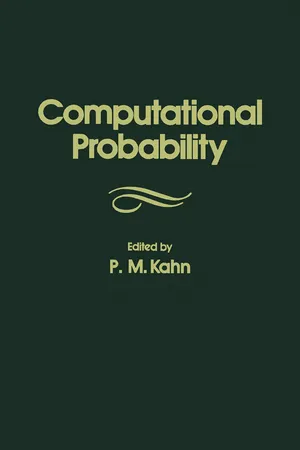
eBook - PDF
Computational Probability
The Proceedings of the Actuarial Research Conference on Computational Probability Held at Brown University, Providence, Rhode Island, on August 28-30, 1975
This is a test
- 352 pages
- English
- PDF
- Only available on web
eBook - PDF
Computational Probability
The Proceedings of the Actuarial Research Conference on Computational Probability Held at Brown University, Providence, Rhode Island, on August 28-30, 1975
Book details
Table of contents
Citations
About This Book
Computational Probability is a collection of papers presented at the Actuarial Research Conference on Computational Probability and related topics, held at Brown University on August 28-30, 1975. This 19-chapter book explores the development of computational techniques in probability and statistics and their application to problems in insurance. It covers six general topics, including computational probability, computational statistics, computational risk theory, analysis of algorithms, numerical methods, and notation and computation. Applications covered both life and nonlife insurance. This book will prove useful to applied mathematicians, statisticians, and computer scientists.
Frequently asked questions
At the moment all of our mobile-responsive ePub books are available to download via the app. Most of our PDFs are also available to download and we're working on making the final remaining ones downloadable now. Learn more here.
Both plans give you full access to the library and all of Perlego’s features. The only differences are the price and subscription period: With the annual plan you’ll save around 30% compared to 12 months on the monthly plan.
We are an online textbook subscription service, where you can get access to an entire online library for less than the price of a single book per month. With over 1 million books across 1000+ topics, we’ve got you covered! Learn more here.
Look out for the read-aloud symbol on your next book to see if you can listen to it. The read-aloud tool reads text aloud for you, highlighting the text as it is being read. You can pause it, speed it up and slow it down. Learn more here.
Yes, you can access Computational Probability by P. M. Kahn in PDF and/or ePUB format, as well as other popular books in Business & Insurance. We have over one million books available in our catalogue for you to explore.
Information
Table of contents
- Front Cover
- Computational Probability
- Copyright Page
- Table of Contents
- Contributors
- Preface
- Chapter 1. Some Ideas in Computational Probability
- Chapter 2. Computational Problems Related to the Galton— Watson Press
- Chapter 3. Central Limit Analogues for Markov Population Processes
- Chapter 4. The Stochastic Nature of Pension Costs
- Chapter 5. An Approximation Method to Calculate the Value of a Maturity Guarantee under a Level-Premium Equity-Based Contract
- Chapter 6. Efficient Sorting by Computer: An Introduction
- Chapter 7. Symbolic Information Pressing
- Chapter 8. APL for Actuaries
- Chapter 9. Backward Population Projection by a Generalized Inverse
- Chapter 10. Accounting Principles for Life Insurance: Reflections on Language and Notation
- Chapter 11. Reversionary Annuities as Applied to the Evaluation of Law Amendment Factors
- Chapter 12. Nonlife Business and Inflation
- Chapter 13. Numerical Fourier Inversion
- Chapter 14. Some Practical Considerations in Connection with the Calculation of Stop-Loss Premiums
- Chapter 15. Simulation of a Multirisk Collective Model
- Chapter 16. Experimental Computation
- Chapter 17. Partitioning for Homogeneity
- Chapter 18. Correlates of Life Insurance Lapsation
- Chapter 19. Some Practical Notes about Solving the Lundberg Risk Equation